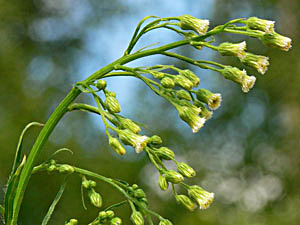
medicinal herbs
Canada Fleabane
Conyza canadensis

Herb: Canada Fleabane
Latin name: Conyza canadensis
Synonyms: Erigeron canadensis
Family: Compositae
Medicinal use of Canada Fleabane:
In traditional North American herbal medicine, Canada fleabane was boiled to make steam for sweat lodges, taken as a snuff to stimulate sneezing during the course of a cold and burned to create a smoke that warded off insects. Nowadays it is valued most for its astringency, being used in the treatment of gastro-intestinal problems such as diarrhoea and dysentery. It is said to be a very effective treatment for bleeding haemorrhoids. The whole plant is antirheumatic, astringent, balsamic, diuretic, emmenagogue, styptic, tonic and vermifuge. It can be harvested at any time that it is in flower and is best used when fresh. The dried herb should not be stored for more than a year. The seeds can also be used. An infusion of the plant has been used to treat diarrhoea and internal haemorrhages or applied externally to treat gonorrhoea and bleeding piles. The leaves are experimentally hypoglycaemic. The essential oil found in the leaves is used in the treatment of diarrhoea, dysentery and internal haemorrhages. It is a uterine stimulant and is also said to be valuable in the treatment of inflamed tonsils plus ulceration and inflammation of the throat. A tea of the boiled roots is used to treat menstrual irregularities. A homeopathic remedy is made from the plant. It is used in the treatment of haemorrhoids and painful menstruation.Description of the plant:

Plant:
Annual
Height:
100 cm(3 1/4 foot)

Flowering:
June toOctober

Scent:
ScentedAnnual
Habitat of the herb:
Light soils on waste and cultivated land, also on walls, avoiding acid soils in Britain.Edible parts of Canada Fleabane:
Young leaves and seedlings - cooked. Boiled, cooked in rice or dried for later use. A nutritional analysis of the leaves is available. The source of an essential oil that is used commercially for flavouring sweets, condiments and soft drinks. The fresh leaves contain 0.2 - 0.66% essential oil.Other uses of the herb:
The plant contains small quantities of essential oil. Since the plant is readily obtainable, extraction of the oil is feasible - it has a special quality that would make it suitable in the making of perfumes with unusual nuances.Propagation of Canada Fleabane:
Seed - we have no information on this species but suggest sowing the seed in spring in situ. An autumn sowing in situ might also be worthwhile.Cultivation of the herb:
Light soils on waste and cultivated land, also on walls, avoiding acid soils in Britain.Known hazards of Conyza canadensis:
Skin contact with the plant can cause dermatitis in some people.Plant information taken from the Plants For A Future.
